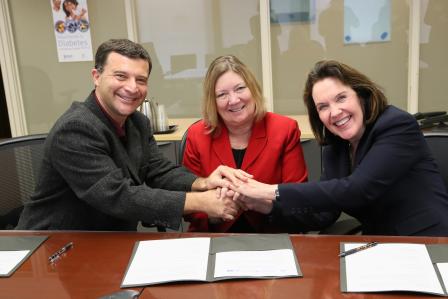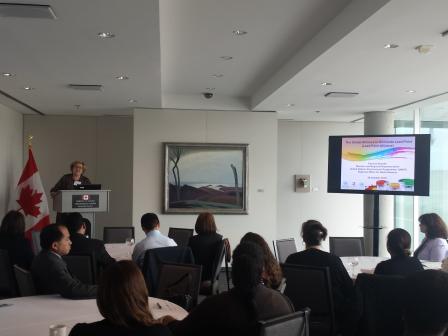EPA Participation in the International Lead Poisoning Prevention Week of Action
 Representatives of the Pan American Health Organization, the U.S. Centers for Disease Control, and the U.S. EPA sign a statement of intent for collaboration on lead paint in Latin America and the Caribbean. (October 2015)
Representatives of the Pan American Health Organization, the U.S. Centers for Disease Control, and the U.S. EPA sign a statement of intent for collaboration on lead paint in Latin America and the Caribbean. (October 2015)Lead poisoning is entirely preventable, yet childhood lead exposure is estimated to contribute to about 600,000 new cases of children with intellectual disabilities every year. Though many countries have taken action, exposure to lead, particularly in childhood, remains of key concern to health care providers and public health officials worldwide. Paints containing high levels of lead are still widely available and used in many countries, although good substitutes without lead are available.
The International Lead Poisoning Prevention Week of Action is an opportunity to mobilize political and social commitment for further progress. (This international program is an expansion of EPA's U.S.-based Lead Poisoning Prevention Week, which occurs during the same week.)
During the campaign week, the Global Alliance to Eliminate Lead Paint aims to:
- Raise awareness about lead poisoning;
- Highlight countries and partners' efforts to prevent childhood lead poisoning; and
- Urge further action to eliminate lead paint.
View recent and past activities in the year of action:
October 2016:
The 4th annual International Lead Poisoning Prevention Week of Action (ILPPW) took place from October 23-29, 2016. EPA joined the World Health Organization (WHO), the United Nations Environment Program (UNEP) and other organizations around the world to promote banning lead paint by 2020 and to raise awareness of the activities of the Global Alliance to Eliminate Lead Paint (Lead Paint Alliance). UNEP, WHO, EPA and IPEN, an international environmental NGO, worked jointly to help develop the ILPPW campaign package, which provided customizable materials in 6 UN languages.
This year’s ILPPW saw the most participation ever with 42 countries all over the globe reporting over 100 events, including social media and press events, workshops and program launches. For example, newspaper articles in Belarus, Zambia urged governments to develop new laws to ban lead in paint and in the Philippines, and Tanzania to hasten finalization and/or implementation of recently developed lead paint laws. In Kenya a forum was held in an elementary school to teach about lead poisoning prevention and third party certification was discussed with industry. In China the government held a workshop on alternatives to lead in paint. In Bangladesh a mass rally and social media campaign were held to call for lead paint laws.
The 2016 ILPPW also included a major communications campaign to promote the Lead Paint Alliance and its efforts to eliminate lead in paint by 2020, reaching millions of viewers via twitter. This effort included the development of infographics and videos demonstrating health impacts of lead, sources of lead in the environment, and actions to reduce exposure, focusing prominently on the elimination of lead in paint by 2020. The campaign also included a twitter-based "Global Lead Chat," in which EPA participated in partnership with UNEP and WHO.
- Learn more about the international lead poisoning prevention week of action. Exit
- View all registered events from this campaign. Ex
- View our full set of Social Media Tools for International Lead Poisoning Prevention Week of Action.
 Patricia Beneke, director of the Regional Office for North America of the United Nations Environment Programme, speaks about the elimination of lead paint at the Canadian Embassy. (October 2015)
Patricia Beneke, director of the Regional Office for North America of the United Nations Environment Programme, speaks about the elimination of lead paint at the Canadian Embassy. (October 2015)October 2015:
EPA played a leadership role in the International Lead Poisoning Prevention Week of Action Exit (October 25-31). Here are some of the great international-focused activities which took place during the week of action.
- Washington, DC: Embassy of Canada, UNEP, WHO and the US Government hosted a forum on "The Elimination of Lead in Paint: How Countries Can Take Action." View more information about the event.
- Washington, DC: Pan American Health Organization (PAHO), EPA and CDC sign new statement of intent for collaboration in Latin America and the Caribbean.
- Bangladesh: High level officials met to discuss regulating lead in paint in their country; human chain formed to call for a “Lead Free Future.”
- Côte de Ivorie: Results of a lead paint study presented to government officials.
- Ethiopia: PAN-Ethiopia invited stakeholders to discuss the lead paint situation, released a new paint analysis and called for voluntary action to eliminate lead from household decorative paints.
- Georgia: The National Center for Disease Control and Public Health conducted a national workshop on “Say No to Lead Paint.”
- Nairobi, Kenya: Students learned about lead.
- Kazakhstan: Meeting held for media and civil society regarding lead and mercury in consumer goods.
- Mombasa, Kenya: Read-Lead social media campaign initiated.
- Nepal: "Stop Lead Paint posters" marked start of country campaign; PSA developed to promote new laws on lead in paint. View video. Exit
- Ibadan, Nigeria: Young Volunteers for the Environment Nigeria held assemblies at 5 schools.
- India: First international conference on "Lead, Environment and Health."
- Philippines: Students in Masambong Elementary School participated in interactive awareness-raising program.
- Republic of Srpska, Bosnia and Herzegovina: The Ministry of Health and Social Welfare held a round table discussion to raise lead awareness.
- Uganda joins in the International Lead Poisoning Prevention Week of Action.
October 2014:
EPA participated in the second International Lead Poisoning Prevention Week of Action (October 19-25). At least 79 events took place in 37 countries across the globe.
Activities included classroom and school events, public outreach, workshop and training sessions, as well as social media and press campaigns.
- Click on the map Exit to find Lead Week Activities that occurred in the United States and around the world!
- View program resources from the 2014 campaign.
- Download the Lead Paint Alliance report of Results from International Lead Poisoning Prevention Week 2014.(4 pp, 3.4M, About PDF) Exit
October 2013:
U.S. EPA participated in the first International Lead Poisoning Prevention Week of Action Exit(October 20-26, 2013). During the campaign week, the Lead Paint Alliance raised awareness about lead poisoning, highlighted countries' and partners' efforts to prevent childhood lead poisoning, and urged further action to eliminate lead paint.
- Report of results from the first campaign: International Lead Poisoning Prevention Week of Action - Summary Report 2013
Contacts
For additional information on EPA's work with the Lead Paint Alliance, contact:
Angela Bandemehr
U.S. Environmental Protection Agency
Office of International and Tribal Affairs (2670R)
1200 Pennsylvania Ave., NW
Washington, DC 20460
E-mail: bandemehr.angela@epa.gov
(202) 564-1427
